No edit summary |
No edit summary |
||
| Line 9: | Line 9: | ||
== Slowing the Water == | == Slowing the Water == | ||
[[Image:Clarifier_Diagram1.jpg|left|450px|thumb|Fig 3: Diagram of the clarifier.]] | [[Image:Clarifier_Diagram1.jpg|left|450px|thumb|Fig 3: Diagram of the clarifier.]] | ||
The first task of the clarifier is to slow down the wastewater it recieves from the [[Arcata Marsh headworks| headworks]](see Figure 3 for water flow). | The first task of the clarifier is to slow down the wastewater it recieves from the [[Arcata Marsh headworks| headworks]] (see Figure 3 for water flow). | ||
==== Water Entering ==== | ==== Water Entering ==== | ||
Water first enters the tank from the influent (wastewater entering the system) pipe. A baffle slows down the velocity of the water to about 0.03-0.05 feet per second and directs the flow of water downward. The baffle is a series of concentric cylinders. This reduces turbidity significantly, allowing solids to settle out on the bottom of the circular tank. | Water first enters the tank from the influent (wastewater entering the system) pipe. A baffle slows down the velocity of the water to about 0.03-0.05 feet per second and directs the flow of water downward. The baffle is a series of concentric cylinders. This reduces turbidity significantly, allowing solids to settle out on the bottom of the circular tank. | ||
| Line 18: | Line 18: | ||
== Settling and Removal Process == | == Settling and Removal Process == | ||
[[Image:Clarifier_skimer.jpg|thumb|left|Fig 5: The skimmer arm can be seen at the top of the photo.]] | [[Image:Clarifier_skimer.jpg|thumb|left|Fig 5: The skimmer arm can be seen at the top of the photo.]] | ||
Suspended solids | Suspended solids are removed from the tank in two ways. | ||
==== Sludge ==== | ==== Sludge ==== | ||
The denser solids settle on the conical bottom of the tank in the form of sludge. A large rake rotates and moves the sludge towards a hopper at the bottom of the tank. The sludge is then moved onto the [[Arcata Marsh digester|digester]](see Figure 3) | The denser solids settle on the conical bottom of the tank in the form of sludge. A large rake rotates and moves the sludge towards a hopper at the bottom of the tank. The sludge is then moved onto the [[Arcata Marsh digester|digester]](see Figure 3) | ||
Revision as of 05:25, 20 November 2008
Overview
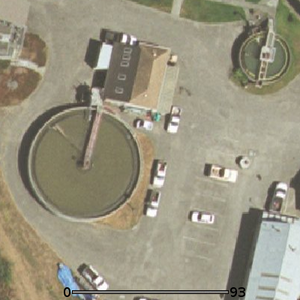
The clarifier operates on the idea of slowing wastewater down so that suspended solids will settle out on the bottom of the tank. In addition to settling on the bottom of the tank, less dense oils and solids will float and settle on the top of the tank. The sludge and scum are then removed, and the water is transported onto the next stage in the wastewater treatment plant. After the entire process is completed the clarifier will have removed 40-60% of suspended solids.
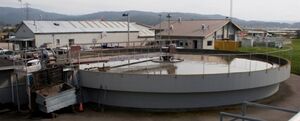
Arcata
The Arcata Wastewater Treatment Plant is equipped with two clarifiers (see Figure 1). The first is a 60 foot diameter tank that is used at all times (see Figure 2). The second is a 26 foot diameter tank provides support during big rains or can be used when the main tank is being maintenanced. both of the clarifiers are center fed clarifiers, meaning the influent (wastewater flowing into the system) is fed from the center, underneath the tank.
Slowing the Water
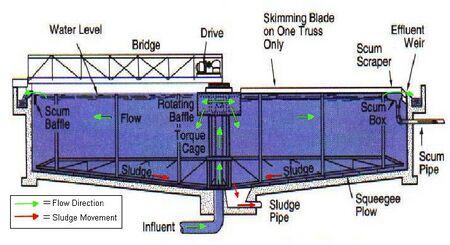
The first task of the clarifier is to slow down the wastewater it recieves from the headworks (see Figure 3 for water flow).
Water Entering
Water first enters the tank from the influent (wastewater entering the system) pipe. A baffle slows down the velocity of the water to about 0.03-0.05 feet per second and directs the flow of water downward. The baffle is a series of concentric cylinders. This reduces turbidity significantly, allowing solids to settle out on the bottom of the circular tank.
Water Exiting
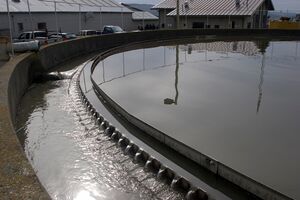
To ensure a consistant water flow the clarifier must also slow down the effluent (wastewater leaving the system) evenly. The perimeter of the tank is designed to accomplish this. A series of v-notched weirs along the edge of the tank slow the water as it departs. Once over the weirs the water enters the effluent ladder (a channel around the outside of the clarfier). An inner baffle that rests behind and above the weirs prevents floating solids from passing over. If water does not flow evenly after entering the tank or as it leaves over the weirs, the settling process will not occur evenly, this is also known as short-circuiting. From the effluent ladder the water flows into a main collection trough and is piped onto the oxidation ponds via the effluent pipe.
Settling and Removal Process
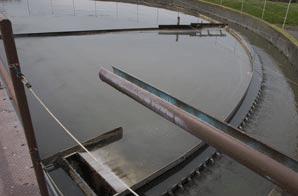
Suspended solids are removed from the tank in two ways.
Sludge
The denser solids settle on the conical bottom of the tank in the form of sludge. A large rake rotates and moves the sludge towards a hopper at the bottom of the tank. The sludge is then moved onto the digester(see Figure 3)
Scum
Lighter solids and oils settle out on the top of the tank in the form of scum. Scum is removed from the tank by a rotating skimmer arm (see Figure 5). The blade like arm collects the scum into a trough on the perimeter of the tank. Once the scum is collected it is transported to a landfill. Both the rakes and arm rotate together as they remove both sludge and scum from the tank.
Refrences
- http://www.cee.vt.edu/ewr/environmental/teach/wtprimer/sedimen/sedimen.html
- Principles of Environmental Engineering and Science/Davis and Masten. 2nd ed
- http://www.environmentalleverage.com/Primary%20Clarifiers-%20Problem%20Areas.htm
- http://ragsdaleassociates.com/WastewaterSystemOperatorsManual/Chapter%203%20-%20Primary%20Treatment.pdf
- http://www.humboldt.edu/~ere_dept/marsh/clarifier.html
- All photographs courtesy of Dr. Dustin Poppendieck, Assistant Professor of Environmental Resource Engineering, Humboldt State University.
<layout name="Project" />